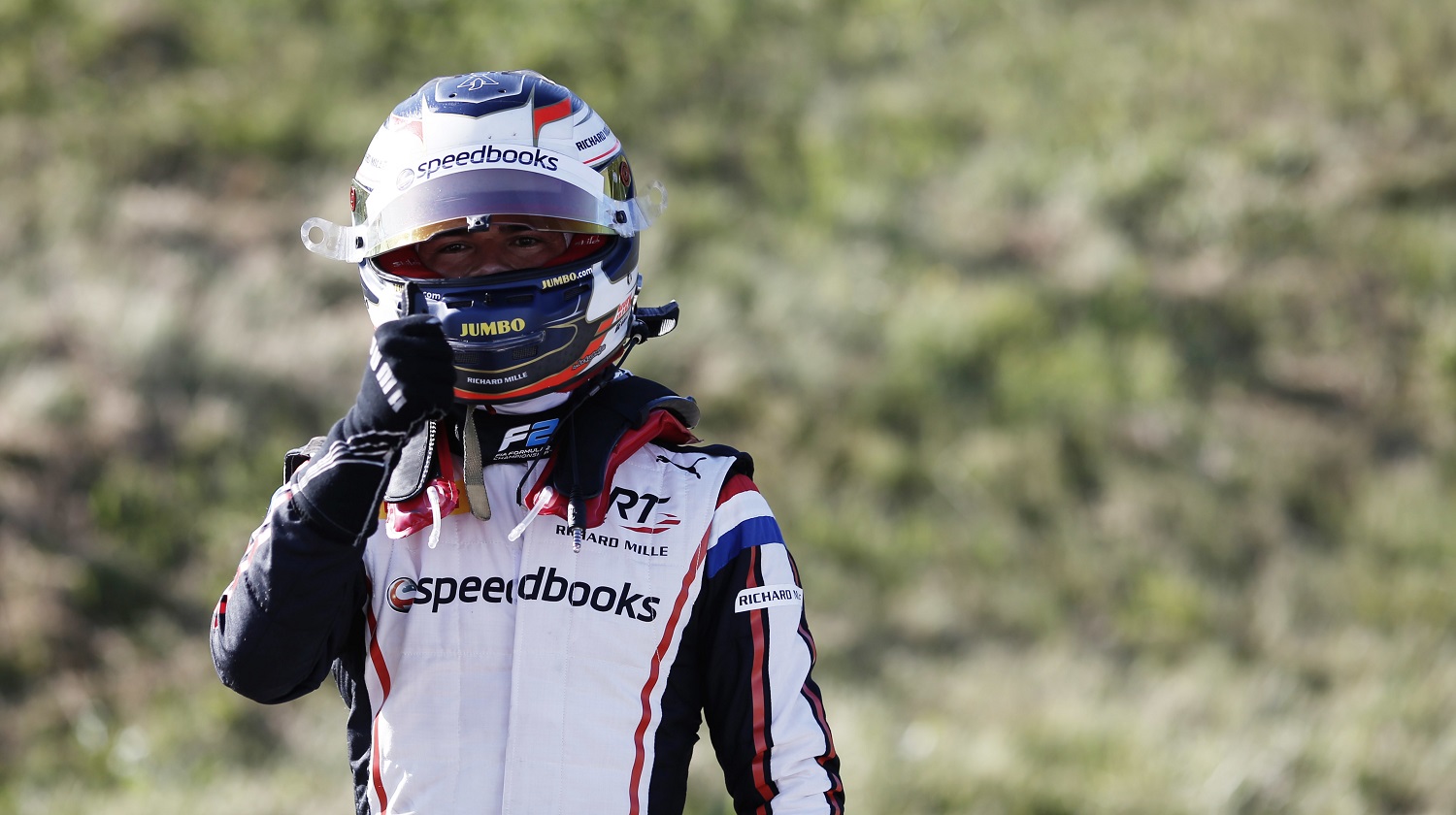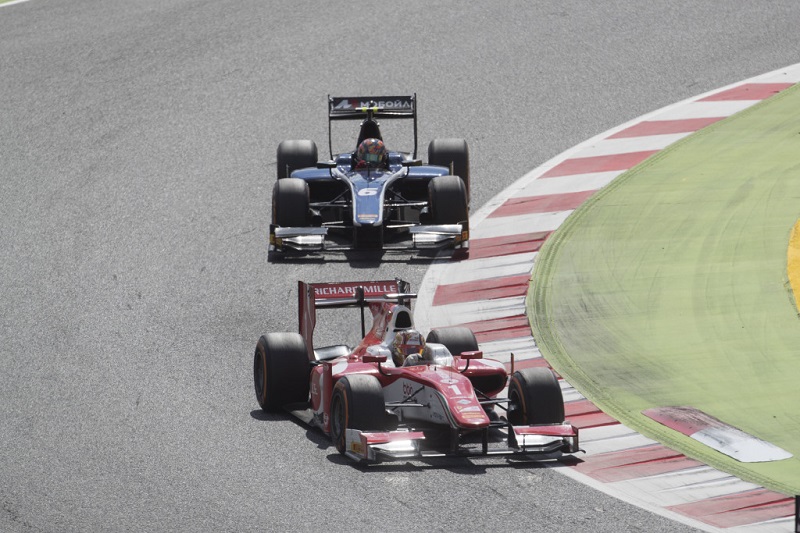
F2 Talk: Can Anyone Catch De Vries?
As F2 enjoys their summer break, we have reached the 2/3 stage of the season with four rounds still to go. In that time, 192 points are still up for grabs and as a result of the final race of Hungary, we have finally had the first drivers officially eliminated from the title fight.
To announce that Ryan Tveter, Pato O’Ward, Arjun Maini, Tatiana Calderon, Mahaveer Raghunathan, Giuliano Alesi and Ralph Boschung, can no longer win the title is perhaps the most non-news story of the year. By the time Spa-Francorchamps is complete we could even see midfield drivers like Juan Manuel Correa and Callum Ilott out of contention, but for the majority, we know only the top five could win the title… or is even that too optimistic?
With four rounds to go, Nyck de Vries sits atop the standings with 196 points, Nicholas Latifi is his nearest competitor on 166, some 30 points back. Is this too much?
Mathematically, obviously not, but when it comes to closing down an ART GP driver in a highly competitive championship, it might be a stretch for the DAMS driver. Breaking it down, 7.5 points a weekend may not seem much, but unlike F1, perfect weekends are rare and far between.
De Vries’ worst weekend was ironically the first, where a sixth and seventh saw him score just 12 points, 25 less than Latifi and 27 less than points leader Luca Ghiotto. Since then though, De Vries has been far more consistent, picking up at least one peice of silverware a weekend. His average points this season has been 24.5 a weekend. By comparison, Latifi’s second best weekend at Catalunya was 31 points and repeating that over the rest of the season would not be enough to dislodge the Dutchman.
[table id=27 /]
Wins vs Consistency
Bahrain has been the catalyst keeping Latifi in this championship for much of the year. That’s not to say he hasn’t beaten De Vries since, with the score 5-3 to Latifi over a whole weekend. But De Vries has been excellent in maximising these bad weekends. It was a point raised by the commentators in Silverstone, but has been evident throughout the year. On the other four weekends De Vries has lost out, he dropped 1 point at Baku and the Hungaroring, while losing 6 points at Catalunya and Silverstone.
By comparison, Latifi struggled to score points at all at Monaco and the Red Bull Ring, dropping 29 and 25 points in turn. Even at Paul Ricard, Latifi failed to secure silverware and lost 13 points, as De Vries almost double of him that round.
Latifi’s inability to maximise these struggled weekends will likely be his downfall. We’ve already seen this with Ghiotto this season, who despite leading the charge after Bahrain, was disqualified in Monaco and failed to score in France, while scoring only 2 points in Baku. Excluding these three rounds, Ghiotto has scored on average 26.6 points a round, but in a series with no drop scores, he now sits fourth overall behind Sergio Sette Camara and 61 points off De Vries.

De Vries still cannot cruise to the title, but it’s clear the points are his to loose right now. An uneventful run to the end of the season with no retirements would almost guarentee him the crown, but the nature of F2 means all pressure rests on the Feature Race. With the grid for the reverse race and the majority of the points determined by the results, De Vries may be in a position where he cannot afford to take risks on strategy and overtaking.
After leaving the McLaren Young Driver programme at the start of the year De Vries has no direct affilitions to F1 and is more likely to focus on his Audi Sport Racing Academy commitments as well as a career in LMP2. Even if he were to win F2, McLaren have already confirmed Norris and Sainz for another season and seats elsewhere are limited. Meanwhile Latifi knows a slot at Williams could easily be available, due to Robert Kubica’s underperformance this season.
So as we enter the final stages, there is still very much the opportunity for Latifi to fight back, taking the risks and fights that his F1 bosses would expect from him, which of course raises the question of what happens if he stumbles. A retirement could easily destroy the Canadians chances at a title, though a 25 point gap to teammate Camara will be comfort for Latifi’s charge.
Comparing to previous seasons
So what about historically, what data can Latifi rely on to prove his fightback is viable?
Arguably not much. In the FIA Formula 2 era, the leader by the Summer break has always gone on to win the championship. For George Russell, he extended his 12 point lead to 68 by the time Abu Dhabi concluded. While Charles Leclerc extended his 50 point advantage over Oliver Rowland to 72 over Artem Markelov by the conclusion of 2017. Both drivers had varying campaigns, with Leclerc building up his advantage in the opening half, which allowed him to hang on after a tougher conclusion, while Russell secured three wins in four rounds to break away from the challenging Norris and Albon.
Latifi’s best example comes from the highly competitive 2016 season, in which five drivers were seperated by 14 points at two thirds distance. The leader at the time Sergey Sirotkin, would finish third as Pierre Gasly eventually beat Prema teammate Antonio Giovanazzi to the title. Even in this scenario though, Gasly was only behind Sirotkin on countback after Germany, with it being the only round Sirotkin actually led the title fight. Gasly had remained in control since the last round, leading most of the season.

In fact, it’s not been since GP2 in 2013 that the driver(s) leading the championship by the summer break have not gone on to be crowned champion. For those that remember, 2013 was the season Stefano Coletti dominated the first half of the season only to not score after Hungary. Both him and Felipe Nasr went into the break on 129 points, though come Abu Dhabi, it would be Fabio Leimer who eventually took the crown ahead of Sam Bird as Nasr and Coletti fell to fourth and fifth respectively.
Even then, Leimer overturned a 19 point deficit, not a 30 point one. And the tradition of the leader extenting his advantage over second place kept strong too, as Leimer held an 18 point advantage over Bird at Hungary, extending slightly to a 20 point advantage over the Brit in Abu Dhabi.
Going further back sees a change in not just the points structure, but also the calendar, before the F1 circus had introduced the concept of a summer break.
The odds are very much against Latifi and to overturn such a disadvantage would require all his skill and fair handful of luck. At 24, time is not on either De Vries or Latifi’s side and the highly competitive FIA F3 series will undoubtably provide a challege for the establishment in 2020 should they chose to stay on.
Despite this, a single Feature Race retirement could throw the championship wide open. All eyes will be on the ART GP.



![Private: [ID: 71rYi-xncgM] Youtube Automatic](https://motorradio-xijqc.projectbeta.co.uk/wp-content/uploads/2024/08/private-id-71ryi-xncgm-youtube-a-1-360x203.jpg)
![Private: [ID: 1SfHxvC8Doo] Youtube Automatic](https://motorradio-xijqc.projectbeta.co.uk/wp-content/uploads/2024/07/private-id-1sfhxvc8doo-youtube-a-1.jpg)
![Private: [ID: H6XRkf6kROQ] Youtube Automatic](https://motorradio-xijqc.projectbeta.co.uk/wp-content/uploads/2024/07/private-id-h6xrkf6kroq-youtube-a-1-360x203.jpg)
![Private: [ID: Kb6w-qAmKls] Youtube Automatic](https://motorradio-xijqc.projectbeta.co.uk/wp-content/uploads/2023/12/private-id-kb6w-qamkls-youtube-a-360x203.jpg)
![Private: [ID: CcpwYw20k3k] Youtube Automatic](https://motorradio-xijqc.projectbeta.co.uk/wp-content/uploads/2024/07/private-id-ccpwyw20k3k-youtube-a-360x203.jpg)

![[ID: x1SiRC5jhW4] Youtube Automatic](https://motorradio-xijqc.projectbeta.co.uk/wp-content/uploads/2022/04/id-x1sirc5jhw4-youtube-automatic-360x203.jpg)
![[ID: lMZ8lAeLubk] Youtube Automatic](https://motorradio-xijqc.projectbeta.co.uk/wp-content/uploads/2022/04/id-lmz8laelubk-youtube-automatic-360x203.jpg)
![[ID: GAYCcnqyFo4] Youtube Automatic](https://motorradio-xijqc.projectbeta.co.uk/wp-content/uploads/2022/04/id-gayccnqyfo4-youtube-automatic-360x203.jpg)
![[ID: Gg142H296QY] Youtube Automatic](https://motorradio-xijqc.projectbeta.co.uk/wp-content/uploads/2022/04/id-gg142h296qy-youtube-automatic-360x203.jpg)
![Private: [ID: PYDb727riQg] Youtube Automatic](https://motorradio-xijqc.projectbeta.co.uk/wp-content/uploads/2023/02/private-id-pydb727riqg-youtube-a-1-236x133.jpg)




